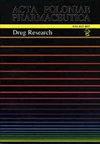HPLC-DAD法检测和测定制剂、血清和唾液中卡马西平的色谱系统优化
IF 0.4
4区 医学
Q4 PHARMACOLOGY & PHARMACY
引用次数: 0
摘要
卡马西平(CBZ)是一种抗惊厥药物,也广泛用于各种疾病,如神经性疼痛、双相情感障碍、顽固性精神分裂症和三叉神经痛。适当的分析程序对于监测、检测和量化药物制剂和生物样品中的CBZ是必要的。寻找新的药物测定方法是现代科学研究中最重要的挑战之一。研究CBZ分析的色谱条件具有重要意义,这对于进一步开发有效的药物测定方法是必要的。本文研究了CBZ在极性RP和苯基己基固定相上的保留率、峰对称性和系统效率。应用了以甲醇(MeOH)和/或乙腈(ACN)为有机改性剂、乙酸缓冲液和二乙胺(DEA)的各种流动相。对不同的色谱系统进行了比较,以获得令人满意的保留率、峰形状和系统效率。采用高效液相色谱-二极管阵列检测(HPLC-DAD)法,采用极性RP柱的最佳色谱体系测定了制剂、人血清和唾液中的CBZ。色谱分析前样品制备采用固相萃取法。所提出的方法在线性、选择性、精密度和准确性方面得到了验证。使用超高效液相色谱-串联质谱法(UHPLC-MS/MS)确认从患者获得的生物样品中CBZ及其主要代谢物的存在。本文章由计算机程序翻译,如有差异,请以英文原文为准。
Optimization of chromatographic systems for detection and determination of carbamazepine in pharmaceutical formulations, serum, and saliva by HPLC-DAD
Carbamazepine (CBZ) is an anticonvulsant drug, widely used also in various disorders like neuropathic pain, bipolar affective disorder, resistant schizophrenia, and trigeminal neuralgia. Appropriate analytical procedures are necessary to monitor, detect and quantify CBZ in pharmaceutical formulations and biological samples. The search for new methods for drug determination is one of the most important challenges of modern scientific research. It is important to study the chromatographic conditions of CBZ analysis, which is necessary for the further development of efficient drug determination methods. In this work, retention, peak symmetry, and system efficiency of CBZ on Polar RP and Phenyl-Hexyl stationary phases were investigated. Various mobile phases containing methanol (MeOH) and/or acetonitrile (ACN) as organic modifiers, acetate buffer, and the addition of diethylamine (DEA) were applied. Different chromatographic systems were compared to obtain satisfying retention, peak shape, and system efficiency. The most optimal chromatographic system with Polar RP column was applied for the determination of CBZ in pharmaceutical formulations, human serum, and saliva by the high-performance liquid chromatography with diode array detection (HPLC-DAD) method. Solid-phase extraction (SPE) method was applied for sample preparation prior to chromatographic analysis. The proposed method was validated for linearity, selectivity, precision, and accuracy. Confirmation of the presence of CBZ and its main metabolites in biological samples obtained from patients was performed using the ultra-high-performance liquid chromatography-tandem mass spectrometry (UHPLC-MS/MS) method.
求助全文
通过发布文献求助,成功后即可免费获取论文全文。
去求助
来源期刊
CiteScore
0.80
自引率
0.00%
发文量
74
审稿时长
6-12 weeks
期刊介绍:
The international journal of the Polish Pharmaceutical Society is published in 6 issues a year. The journal offers Open Access publication of original research papers, short communications and reviews written in English, in all areas of pharmaceutical sciences. The following areas of pharmaceutical sciences are covered: Analysis, Biopharmacy, Drug Biochemistry, Drug Synthesis, Natural Drugs, Pharmaceutical Technology, Pharmacology and General.
A bimonthly appearing in English since 1994, which continues “Acta Poloniae Pharmaceutica”, whose first issue appeared in December 1937. The war halted the activity of the journal’s creators. Issuance of “Acta Poloniae Pharmaceutica” was resumed in 1947. From 1947 the journal appeared irregularly, initially as a quarterly, then a bimonthly. In the years 1963 – 1973 alongside the Polish version appeared the English edition of the journal. Starting from 1974 only works in English are published in the journal. Since 1995 the journal has been appearing very regularly in two-month intervals (six books a year). The journal publishes original works from all fields of pharmacy, summaries of postdoctoral dissertations and laboratory notes.

 求助内容:
求助内容: 应助结果提醒方式:
应助结果提醒方式:


